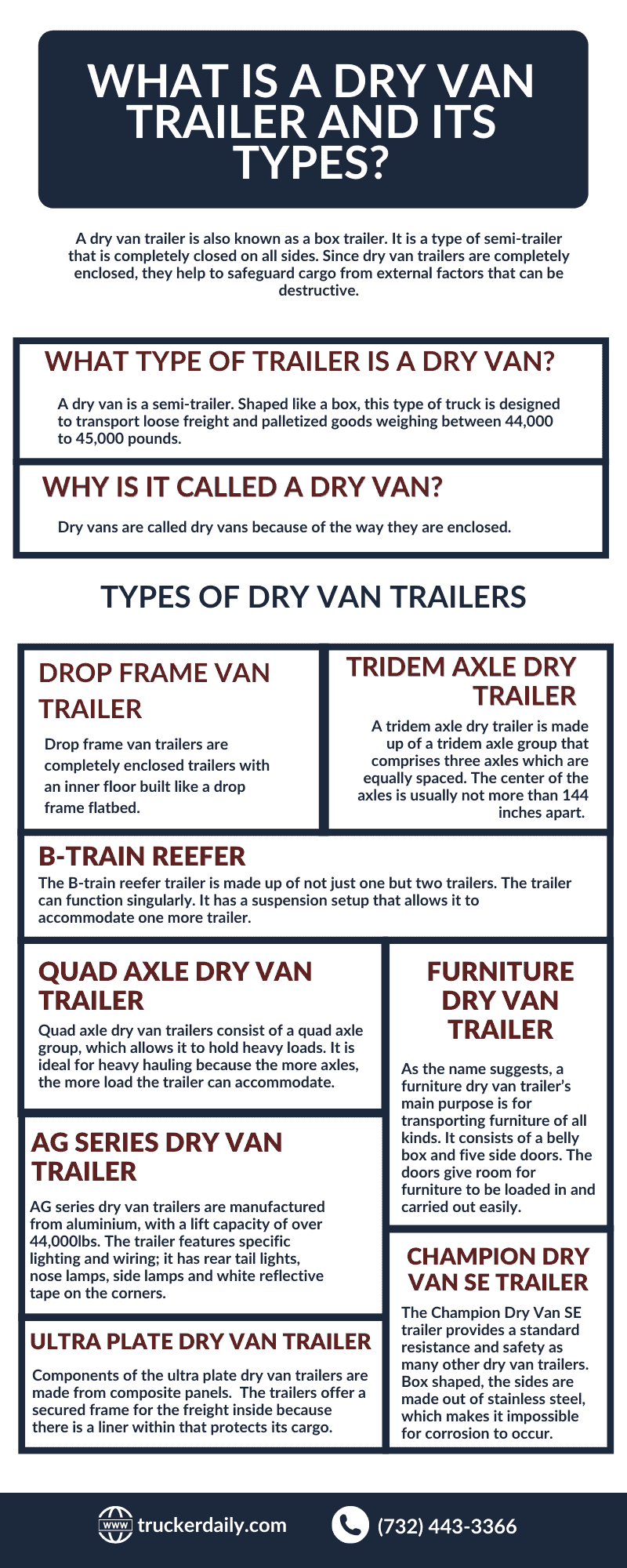Because of their versatility, dry vans are one of the most commonly used equipment types in my freight brokerage. And what makes it even more versatile is the fact that it has many types. But what is a dry van and what types of dry vans are available for you to choose from?
A dry van trailer is also known as a box trailer. It is a type of semi-trailer that is completely closed on all sides. Since dry van trailers are completely enclosed, they help to safeguard cargo from external factors that can be destructive.
But that’s not all there is to know about dry vans. Below, I’ll share with you everything I learned about dry vans for the past 15 years.
#DidYouKnow? The average 53 foot trailer/dry van actually can weigh up to 15,000 pounds. pic.twitter.com/LzmW1iPEU6
— AB Trailers LLC (@ABTrailersLLC) December 2, 2019
What type of trailer is a dry van?
A dry van is a semi-trailer. Shaped like a box, this type of truck is designed to transport loose freight and palletized goods weighing between 44,000 to 45,000 pounds.
This is unlike a reefer that can only take 42,500 to 44,000 pounds.
Lofty in size, dry van trailers are usually 13.5 feet (163 inches) in height, 8.5 feet wide and between 48 - 53 feet in length.

Why is it called a dry van?
Dry vans are called dry vans because of the way they are enclosed.
Dry van trailers can transport all kinds of shipments except oversized and perishable shipments.
This is because the floor of the encased cargo inside cannot support excessive amounts of weight.
Also, the container of a dry van trailer is not temperature-regulated, which is why it is not the best option to transport perishable goods.
The most frequently transported goods in dry van trailers are machinery, electronics, fabrics, types of furniture and textiles amongst others.
Dry van trailers are generally used to transport shipments but they differ in size, style and weight capacity.
Here are some of the types of dry van trailers:
die cast promotions 1/64
Peterbilt 389 Dry Van Trailer
Dysart's Transportation#dcp#diecastpromotions pic.twitter.com/mNcDGXxfvT
— 𝓜.𝓢.𝓦 ®︎ (@msooo8008) March 8, 2020
Types of Dry Van Trailers
Drop frame van trailer
Drop frame van trailers are completely enclosed trailers with an inner floor built like a drop frame flatbed.
These trailers are usually used to transport big loads of boxes, including furniture and other bulky freight.
However, the maximum weight drop frame van trailers can hold is about 40,000 lbs, due to the low profile tires that are used.
The inner compartment of many drop frame van trailers are spacious, most are over 53’’ foot in length, 102’’ width and 13’6’’ in height.
Drop frame van trailers are ultimately one of the best moving vans, commonly used to transport large home furnishings such as ; freezers, fridges, air conditioners, wardrobes and many more due to the large inner space.
Tridem axle dry trailer
A tridem axle dry trailer is made up of a tridem axle group that comprises three axles which are equally spaced. The center of the axles is usually not more than 144 inches apart.
This allows the weight of the load to be equally balanced on the trailer. All three axles are attached to the framework and are all designed with identical tires and wheel assemblies.
Tridem trailers can convey loads weighing up to 50,000 lbs, provided that within a tri-axle group, none of the axle load exceeds 18,000 lbs.
This type of trailer is commonly used for transporting large and heavy loads such as heavy construction equipment, farm equipment, and metals among others .
Unlike some other dry van trailers, tridem axle trailers can withstand stormy weather. In the winter time, tridem axle trailers are mostly used to transport important shipments, because they offer a stronger hold on loads during winter storm conditions.
The extra wheel surface of a tridem axle dry trailer allows it to stay steady. This helps to prevent shipments from swaying out of place and possibly hitting the walls of the trailer which could cause damage.
B-train reefer
The B-train reefer trailer is made up of not just one but two trailers.
The trailer can function singularly. It has a suspension setup that allows it to accommodate one more trailer.
The suspension setup has a pick up plate for a second trailer to connect. When the suspension slides back, it shows the hook up where the second trailer can be hooked.
Braking hookups and full power for the second trailer comes from the first trailer, through the sliding suspension.
This type of trailer is used for transporting freight which is of low weight, such as: electronics, clothing, and other household items, provided that they are not heavy.
The two trailers give room for bigger loads to be transported, which is why it can also be used as a moving van.
Trailers that are 30-feet long or less are best for the B- train system.
Quad axle dry van trailer
Quad axle dry van trailers consist of a quad axle group, which allows it to hold heavy loads.
It is ideal for heavy hauling because the more axles, the more load the trailer can accommodate.
A gross total of a weight load up to 50 tons can be conveyed on a quad-axle dry van trailer.
This trailer is commonly used to haul heavy loads of paper cull, paper, recycled materials and many other commodities.
Furniture dry van trailer
As the name suggests, a furniture dry van trailer’s main purpose is for transporting furniture of all kinds.
It consists of a belly box and five side doors. The doors give room for furniture to be loaded in and carried out easily.
Making use of other conventional dry van trailers to transport furniture might prove difficult, because they are not built for that purpose.

Which dry van trailer is the best?
Dry van trailers are essentially one of the safest trucks to transport non-perishable items. Which is why these trucks are commonly used for major trucking business in the United States, Canada and Mexico.
There are different models of dry van trailers built by truck manufacturing companies.
Here are some of the best models of dry van trailers:
1. AG series Dry van Trailer
AG series dry van trailers are manufactured from aluminum, with a lift capacity of over 44,000lbs.
The trailer features specific lighting and wiring; it has rear tail lights, nose lamps, side lamps and white reflective tape on the corners.
This series of dry van trailers run on 8 wheels, and offer a large container big enough to convey all kinds of shipments, excluding oversized ones.
2. Champion Dry Van SE Trailer
The Champion Dry Van SE trailer provides a standard resistance and safety as many other dry van trailers.
Box shaped, the sides are made out of stainless steel, which makes it impossible for corrosion to occur.
The trailer features a patented SSL panel lining. The SSL panel has a stronger density than the conventional hardwood as some dry van trailers have instead.
For commodities like machinery and electronics, Champion dry van SE trailers may be best to transport them.
3. Ultra Plate Dry Van Trailer
Components of the ultra plate dry van trailers are made from composite panels.
The trailers offer a secured frame for the freight inside because there is a liner within that protects its cargo.
Conclusion
Since the manufacturing of dry van trailers, more and more trucking companies and private truckers have chosen to use dry van trailers.
This is because many types of freight can be hauled in a dry van trailer. the trailer has a spacious compartment that gives room for a large quantity of goods to be transported.
Through this, truckers can transport more goods in just one trip with less worries about the safety of the goods. Because a dry van trailer can secure goods from external damaging factors due to the enclosed sides.
Sources:
- https://www.grandrapidstransport.com/equipment/drop-deck-vans/ accessed June 22, 2021
- https://www.plslogistics.com/blog/what-is-a-dry-van-trailer-8-shipping-facts accessed June 22, 2021
- https://www.transportationservices.ca/equipment/dry-vans/tridem-axle-vans/ accessed June 22, 2021
- https://arcb.com/blog/what-you-need-to-know-about-dry-van-shipping accessed June 22, 2021
- https://www.lawinsider.com/dictionary/tridem-axle accessed June 22,2021
